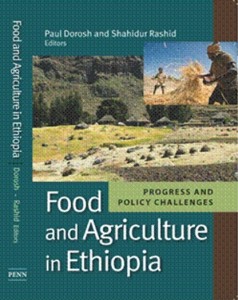Food and Agriculture in Ethiopia (2012, International Food Policy Research Institute)
Editors: Paul Dorosh and Shahidur Rashid
Published by University of Pennsylvania Press ISBN 978-0-8122-4529-5
The book is designed to provide empirical evidence to shed light on the complexities of agricultural and food policy in today’s Ethiopia; highlight major policies and interventions of the past decade; and provide insights into building resilience to natural disasters and food crises. It is hoped that students, researchers, policy analysts, and decision makers will find this book useful regarding Ethiopia’s political, economic, and agricultural transformation as well as a resource on major food policy issues in the country.
The authors gratefully acknowledge the Ethiopian Central Statistical Agency (CSA), the Food and Agriculture Organization (FAO), and various government and international agencies for furnishing the data that made the analyses possible.
Read an excerpt below:
INTRODUCTION: Ethiopia is often perceived as a country of droughts, widespread poverty, and economic stagnation. Indeed the country experienced severe famines in both the 1970s and the 1980s, which resulted in a depletion of household assets and savings and caused excess mortality, estimated at 250,000 in 1972-74 and 590,000 in 1984-85 (Africa Watch 1991; de Waal 1997). More localized food shortages have often been less documented, such as the one in Somali region during 1999-2000 whereby an estimated 100,000 people died following three consecutive years of drought (Hammond and Maxwell 2002). Other serious production shortfalls related to droughts, such as that in 2003, significantly reduced the food production and consumption of millions of households. Moreover, even in normal years, the level of food insecurity is high, with an estimated 44 percent of the population undernourished, 35 percent of children under five years of age underweight, and 11 percent of children dying before the age of five (von Grebmer et al. 2010).
Yet, much of Ethiopia differs sharply from the grim view suggested by these figures. Most of the rural population resides in rainfall-sufficient areas in which harvests are normal in most years. Nationally, the available data suggest that food production and availability are increasing due to increases in area cultivated and, in 2005-09, increases in yield. Outside the agricultural sector itself, massive investments in roads and the spread of cell phone technology have greatly increased access to markets, urban centers, services, and information for tens of millions of rural Ethiopians. And per capita incomes increased by over 50 percent from 2001 to 2009 (World Bank 2010). You can find the PDF version of the book here.
